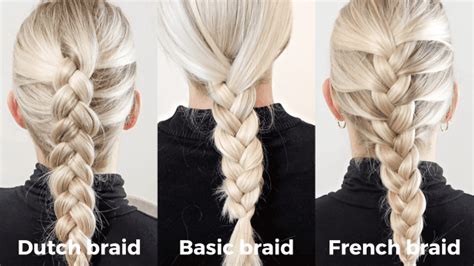Introduction
Braiding is an art form that has been passed down through generations. It is a versatile skill that can be used to create a variety of hairstyles, from simple everyday looks to elaborate updos. There are many different types of braids, but two of the most popular are the Dutch braid and the French braid.

Dutch Braid vs French Braid: What’s the Difference?
The Dutch braid and the French braid are both three-strand braids, but they have a different appearance and construction.
Dutch Braid:
– Also known as an inside-out braid
– The strands are crossed under each other, rather than over each other
– Creates a raised, textured effect
French Braid:
– The strands are crossed over each other
– Creates a flat, smooth effect
Which Braid is Right for You?
The best braid for you depends on your hair type, the occasion, and your personal preferences.
Dutch Braid:
– Best for thick, coarse hair
– Can create a more voluminous look
– Good for keeping hair out of your face during activities
French Braid:
– Best for fine, thin hair
– Can create a more elegant look
– Good for special occasions or formal events
How to Braid: Dutch vs French
Dutch Braid:
- Section off a small piece of hair from the top of your head.
- Divide the section into three strands.
- Cross the right strand under the middle strand.
- Cross the left strand under the new middle strand (which was previously the right strand).
- Repeat steps 3-4, adding small sections of hair from the sides as you go.
- Continue braiding until you reach the end of your hair.
- Secure the braid with a hair tie.
French Braid:
- Section off a small piece of hair from the top of your head.
- Divide the section into three strands.
- Cross the right strand over the middle strand.
- Cross the left strand over the new middle strand (which was previously the right strand).
- Repeat steps 3-4, adding small sections of hair from the sides as you go.
- Continue braiding until you reach the end of your hair.
- Secure the braid with a hair tie.
Pros and Cons of Dutch vs French Braids
| Feature | Dutch Braid | French Braid |
|---|---|---|
| Appearance | Raised, textured | Flat, smooth |
| Hair type | Thick, coarse | Fine, thin |
| Occasion | Casual, everyday | Formal events |
| Difficulty | Intermediate | Beginner |
Pain Points and Motivations
Pain Points:
- Dutch braids can be more difficult to master than French braids.
- French braids can be too tight and uncomfortable for some people.
Motivations:
- Dutch braids can create a more voluminous look.
- French braids can create a more elegant look.
- Both types of braids can help to keep hair out of your face and tidy.
Step-by-Step Approach
Dutch Braid:
- Brush your hair to remove any tangles.
- Section off a small piece of hair from the top of your head.
- Divide the section into three strands.
- Cross the right strand under the middle strand.
- Cross the left strand under the new middle strand (which was previously the right strand).
- Add a small section of hair from the right side to the right strand.
- Cross the right strand (with the added hair) under the middle strand.
- Add a small section of hair from the left side to the left strand.
- Cross the left strand (with the added hair) under the new middle strand (which was previously the right strand).
- Repeat steps 6-9 until you reach the end of your hair.
- Secure the braid with a hair tie.
French Braid:
- Brush your hair to remove any tangles.
- Section off a small piece of hair from the top of your head.
- Divide the section into three strands.
- Cross the right strand over the middle strand.
